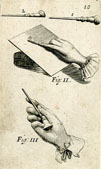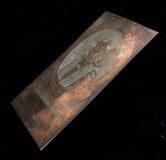Engraving
The earliest engravings to make prints can be dated to the fifteenth century. Engravings
were usually made on copper plates. The act of engraving was a skilled and laborious task.
The engraver would make incisions on the plate using a burin, a small steel rod with a
sharpened V-shaped point. The burin would be pushed forward through the metal, cutting a
V-shaped groove, the width of the line being dependent on how deeply the burin was pushed
into the plate. The curls of copper at the side of the line would then be scraped off. The
completed design would consist of a series of incised lines on the copper plate. After
warming the plate, printing ink would be applied using a dabber, the ink being worked into
the lines of the plate. The ink on the surface area of the plate would then be carefully
wiped off with cloths, leaving only ink lying in the engraved lines.
 The printer would then place the plate face up in an
intaglio press, a sheet of dampened paper would be placed on top of it, and cloths placed on
top of both so as to even out the pressure when the plate passed through the rollers of the
press.
The printer would then place the plate face up in an
intaglio press, a sheet of dampened paper would be placed on top of it, and cloths placed on
top of both so as to even out the pressure when the plate passed through the rollers of the
press.
 The plate was then passed
between the rollers, the pressure of this forcing the paper into the grooves of the plate
and dragging out the ink. The paper would then be hung up to dry and the plate re-inked for
a further impression. The pressure of the intaglio press was responsible for the platemark,
the indented line where the edge of the plate has been pushed into the paper. Engravings and
other intaglio prints can be distinguished from woodcuts by close inspection of the ink,
which is usually slightly raised on the paper in intaglio prints, a result of the paper
dragging the ink up when passed through the press. Engravings themselves can usually be
identified by the steadiness of the lines, and the fine points at the beginning and ends of
lines as the burin is first pushed into the plate and then lifted up at the end of the
line.
The plate was then passed
between the rollers, the pressure of this forcing the paper into the grooves of the plate
and dragging out the ink. The paper would then be hung up to dry and the plate re-inked for
a further impression. The pressure of the intaglio press was responsible for the platemark,
the indented line where the edge of the plate has been pushed into the paper. Engravings and
other intaglio prints can be distinguished from woodcuts by close inspection of the ink,
which is usually slightly raised on the paper in intaglio prints, a result of the paper
dragging the ink up when passed through the press. Engravings themselves can usually be
identified by the steadiness of the lines, and the fine points at the beginning and ends of
lines as the burin is first pushed into the plate and then lifted up at the end of the
line.